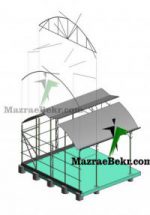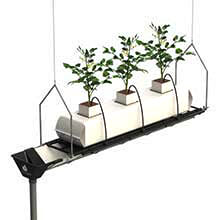Greenhouse Strawberry
Fragaria Greenhouse Strawberry
Strawberries are savory fruits and a pleasant aroma of spring. This fruit is rich in vitamins C, B and minerals, and this popular fruit is grown in two ways: greenhouse and farm cultivation, wild strawberry cultivars with the scientific name F.vesca in some parts of northern Iran, alborz and Azerbaijani slopes naturally grow strawberries that its production will be very profitable for breeders and statistical analysis. The cultivation of this fruit indicates the interest in its production is increasing. In Iran, strawberry cultivation areas are Kurdistan, Markazi, Azerbaijan and Khorasan, with the highest production rates related to Kurdistan.
Botanical Specifications:
Strawberries are made of fragaria, a very short stem called a crown, the length of this short stem is up to 2.5 cm, surrounded by sequential leaves, there is a bud on the axis of each leaf that can be turned into a side collar or a trending crown, or it remains in a sleepy state. The vascular snake passes around this tissue to enter the petiole and leaves. The roots are permanently primitive with structural roles and a number of secondary roots for water and food absorption. It is also possible to create misplaced roots from the collar. This plant has compound leaves that have 3 oval leaflets with relatively long and fluffy petioles, which are dark green and transparent in some cultivars. The flower building consists of 5 white petals, and the flower bowl consists of 5 green petals that are almost connected to each other in the lower part. The number of petals in some cultivars is more than 5. The number of flags is approximately 20, and the mass is large and spirally placed on the clump and together with the ninage has formed a relatively drawn form of hazelnut. Separated. There is one egg in each ovary and the number of seeds is produced in the number of hazelnuts. After inoculacies of flowers and petal falls, the ninage gradually grows and becomes fleshy. Strawberry fruit is a false and complex set, the real fruit of strawberries is the same as small brown hazelnuts on the texture of the hannaj. Complete and suitable pollination is a prerequisite for the production of well-formed fruits because each hazelnut produces auxin hormone to grow the cloak tissue below itself. Other hormones such as gibberelline and cytokine are also involved in the growth and development of fruits, but are less important. Inappropriate temperature causes insufficient pollination and disfigurement of fruits. Spring frost causes loss of pollen grains or aggregates, which reduces pollination and deformation of fruits. Deficiency of elements such as calcium, magnesium and zinc is involved in the deformation of fruits.
Proliferation of strawberries
Sexual proliferation: The increase of strawberries by seed is specific to cultivars that do not naturally produce stalks or cultivars that have few ingent stems and also for the production of new cultivars .
Asexual ejection: In asexual multiplication through plant division, plants that have had strong and good growth, after ejection from the ground to a few small plants, each of which has independent roots, divide and transplant them in the main location.

Strawberry cultivation in greenhouse
Since cultivation in greenhouse increases yield about 10 times compared to field cultivation, this increase in yield in hydroponic cultivation is much higher and it is easy to control pollution especially in strawberry production due to high susceptibility to diseases. Although hydroponic greenhouse construction is relatively costly, but higher efficiency and less crop waste will be much more cost effective in the long run than conventional greenhouses.
Strawberry cultivation begins in early October and after 3 to 4 months, the plants go to the fruiting phase. On average, the harvest period will be 4 to 5 months, and after harvesting the transplantation period or the pajoush that produces the plant begins, approximately one period of which is 2 to 3 months. The proper cropping distance is 25 to 30 cm and generally about 20 plants are cultivated in one square meter, if planted properly, taking care and selecting suitable varieties, we can harvest an average of about 400 grams of each plant.
Strawberries have many varieties. The differences between cultivars include plant growth ability, abundance of fruit production, resistance and susceptibility to diseases, ripening time of fruits, fruit quality after freezing, firmness, size, color, shape and taste of fruits. Some of the most important dominant varieties cultivated and cultivated in our country include:
Paros: Short day, its fruits are large, conical with bright red color is orange, relatively mid-clay and especially in greenhouse conditions is good.
Sandy loamy soils with abundant food and good drainage are suitable for planting strawberries, soil should be able to hold enough water for the plant, in light soil and with optimal organic matter, the development of roots is more suitable for strawberries 5.8 to 6.2 if the amount of soil lime is too much, the complication of chlorosis or yellowing of the leaves occurs.
Feeding in a soil greenhouse of 3 to 5 kg of complete chemical fertilizer in 100 square meters is given to the bed. In early autumn or spring, plowed the ground and then mixed animal and chemical fertilizers and 10 tons per hectare of decayed animal fertilizer with soil and based on soil experiments amounted to 80-100 kT in three stages, 100 to 150 kB pure potassium and 60 to 80 Kilos of phosphorus per hectare are used.
In hydroponic culture, neutral compounds are used for substrate. Commonly used compounds were Pete Moss 64% + Cocopeat 44% and Peat Moss 64% + Perlite 44%. Strawberry roots are sensitive to flooding and to prevent stress to plants pots and planting containers should have proper drainage so that the residual nutritional solution is removed after moistening the root environment and substrate. This liquid is then collected in the recycling tank and reused.
Careful monitoring of the properties of this liquid is vital because after a while the chemical properties of this liquid are changed and in this case it must be modified or replaced. In the nutritional solution, the pH of the range of 5.8 and electrical conductivity of about 1.5 to 1.7 dS/m should be adjusted, strawberries can be cultivated in containers such as polyethylene envelopes, plastic pots, styrofoam containers available in different shapes and dimensions.
The cultivated containers should be arranged together in such a way that the sunlight shines completely into the plant and also the largest number of pots can be placed in the greenhouse space. Strawberry pots are either placed vertically on each other, or put together horizontally. Placing cultivation pots vertically on each other makes it possible to place more pots and plants per unit area compared to horizontally picking pots together. However, less light may reach the lower plants. The horizontal system can be embedded in multiple levels.
In hydroponic cultivation, nutrient solution should be considered according to plant growth stage and plant requirements, for example, in vegetative growth stage, the amount of oats required by plants is higher and in flowering phase more potassium is required for plants. Normally, after one week, the pH of the substrate is measured and in case of change from the optimum level, the leaching of the substrate is done.
Common fertilizers for feeding plants with irrigation water are urea, ammonium nitrate, ammonium sulfate, ammonium phosphate, phosphoric monoacic acid, potassium phosphate, potassium nitrate, potassium sulfate, calcium nitrate and magnesium nitrate.
Amount of nutrients needed for strawberries at different growth stages:
| Growth stage | Nitrogen | P | Potassium | Calcium | Magnesium |
| Concentration (mg/L) | |||||
| Vegetative establishment and growth | 50-30 | 25-20 | 60-45 | 50-40 | 45-40 |
| The first stage of fruiting | 85-70 | 25-20 | 80-60 | 90-70 | 45-40 |
| The first stage of fruit growth | 85-80 | 25-20 | 80-60 | 90-80 | 45-40 |
| The second and third stages of fruiting and their growth | 85-80 | 25-20 | 80-60 | 90-80 | 45-40 |
| The fourth stage of fruiting and growing them | 60-55 | 25-20 | 60-55 | 80-70 | 45-40 |
Temperature: The greenhouse temperature should be adjusted to 10 to 12 °C at the beginning of the cultivation , and by increasing the intensity of light, the temperature should also increase to 18 to 20 °C. Immediately after cultivation, enough irrigation should be done in humid and relatively hot conditions. Strawberry tecting is sufficient. In case of moisture efferation, ventilation is done.
Light: Strawberry is one of the light-loving plants and requires sunlight for at least 6 to 8 hours to produce fruit, lack of adequate and suitable light in the planting place reduces fruit production and increases the sensitivity of fruits to fungal diseases, especially powdered mildew and gray mold.
The average concentration of atmospheric co2 gas is about 354 ppm. It has been shown that increasing the amount of this gas in the greenhouse environment with the help of special generators for carbon dioxide emissions, burning natural gas, using gas capsules, etc. It can increase yields by between 8 and 34 percent.
Also, the quality of fruits increases under increasing concentrations of CO2. The amount of soluble solids, fructose, glucose and total fruit sugars increased and citric acid and malic acid decreased.
Also, compounds that make up the aroma of strawberry fruit (including ethylhexanoate, ethylbutanate, methylbutanonate, methylhexanate, hexyl acetate, furanal, linalool and methyl octanoate) are also improved by increasing carbon dioxide concentrations in the greenhouse atmosphere.
In greenhouse strawberry irrigation , you should be careful that the ground is uniformly moistened, most of the root volume of this plant is located in a shallow depth of soil and about 15 cm on the soil surface, so this plant is sensitive to soil dryness and drought stress causes lack of flowering, fruiting or shrinkage of fruits, pale leaves as well as reddish-brown margins in It leaves, as well as excessive irrigation causes the leaves to wilt and even the plant disappears.
In hydroponic greenhouses, 10-12 irrigation rounds are carried out with nutrient solution. In order to prevent the risk of fruit rot due to high moisture content, greenhouse should be hydrated in a timely manner and reduced excess moisture by dry heat. Also, due to the susceptibility of strawberry plants to fungal diseases, appropriate fungicides should be used in the first irrigation to prevent the spread of fungicides.
Care needed after implantation
- Covering the soil by suitable mulches such as straw, sawdust and plastic, which makes the fruit not directly in contact with the soil and in addition to controlling the moisture of the bed, prevents the diseases of decay.
- Timely control of diseases, pests and weeds (including the most important pests of tick strawberries and tryps and its important diseases can be called powdered whites and anthragnosis).
- Cut off the processed stems at the time of growing season to prevent the weakening of the native bushes.
Harvesting and packing strawberries
Since this fruit is inferior and there is no significant change in their quality after harvesting, harvesting should be done when fruit harvesting indices (soluble solids above 5.5, total acidity about 0.6%) on the mother plant have reached the optimum level. Strawberries have short post-harvest fruits due to their delicate texture. Fruit harvesting is best when the air is cooler and the harvested fruits should be placed in a cool place immediately. It is better to harvest the fruit with a little bit of the tail so that there is no pressure on the fruit at the time of harvest. Due to the severe vulnerability of the fruit, it should be packed in shallow boxes and careful during transportation. Strawberries are one of the most percevive fruits and should be harvested in a completely ripe state. Excessive metabolic activities of strawberries can cause its loss even without the presence of spoiling agents. The structure of strawberries is such that it is vulnerable to corruption, this product has a very thin coating layer that is easily destroyed, as well as soft fruit meat, making it very vulnerable to impact and pressure. The injuries initially cause the softness of the strawberries, then provide a suitable place for pathogens to attack. High metabolic activities, fruit sensitivity to damage and microbial spoilage are problems that producers should consider at the time of harvesting and storage.
Strawberry Exports
One of the problems of exporting Strawberry in Iran is the residues of pesticides and decay diseases caused by inappropriate packaging of this product, which can be supplied by using biological pesticides and fungicides and using appropriate solutions to improve postharvest conditions. If you want to make a greenhouse for strawberry you can call mazraebekr company.









